

The online shift is happening — and fast — for the home improvement industry, as discussed in Part 1 of this series. Therefore, it’s imperative that Tools & Home Improvement brands follow suit and figure out how to accelerate sales online, and more specifically on Amazon.
Easier said than done though, right? Nearly everything about Amazon — from its endless assortment and ultra-competitive pricing to dynamic merchandising and next-day Prime delivery — is quite different than any other retailer you’ve ever encountered.
Doing business on the Amazon platform really does require a new way of thinking to succeed.
Here are 5 things you need to know:
1. Shoppers have (a lot) more choice on Amazon
In brick-and-mortar stores, such as The Home Depot, a shopper has a limited assortment of products to choose from. But on Amazon, the assortment is much larger (see the below chart as an illustration).
What this means is your list of competitors multiplies exponentially on Amazon. It also means that competitors winning on Amazon may not be the same ones you’re competing against in brick-and-mortar retailers.
So, cracking the code on competing with the long tail — e.g., the importance of search placement, winning Page 1, and other execution-oriented tactics covered in our recent webinar — becomes increasingly paramount.
The endless shelf: Tools & Home Improvement
Difference in assortment on Amazon.com vs. what’s available for pick up at The Home Depot store in suburban Atlanta
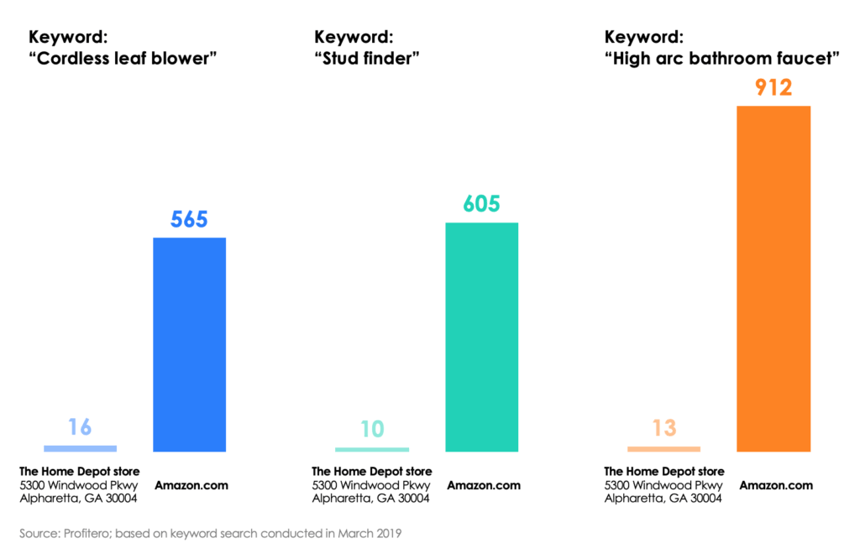
2. Your competitors also include 3P sellers
Amazon’s third-party (3P) marketplace opens up a whole new set of challenges too. It’s an unfamiliar and uneasy feeling, but you will lose some control of your brand to 3P sellers. Marketplace sellers could be using non-compliant product descriptions or images, which could inevitably damage your brand equity. 3P sellers also could be selling below the Minimum Advertised Price, which can result in your brand losing the buy box, as well as triggering The Home Depot or Lowe’s to price-match. So, it’s best to get a handle on 3P activities as much as possible.
The level of 3P activity varies across categories, i.e., there is no standard. For example, the chart below shows that the reach of 3P sales ranges from 36% for Mowers and Outdoor Power Tools to 55% for Kitchen & Bath Fixtures.
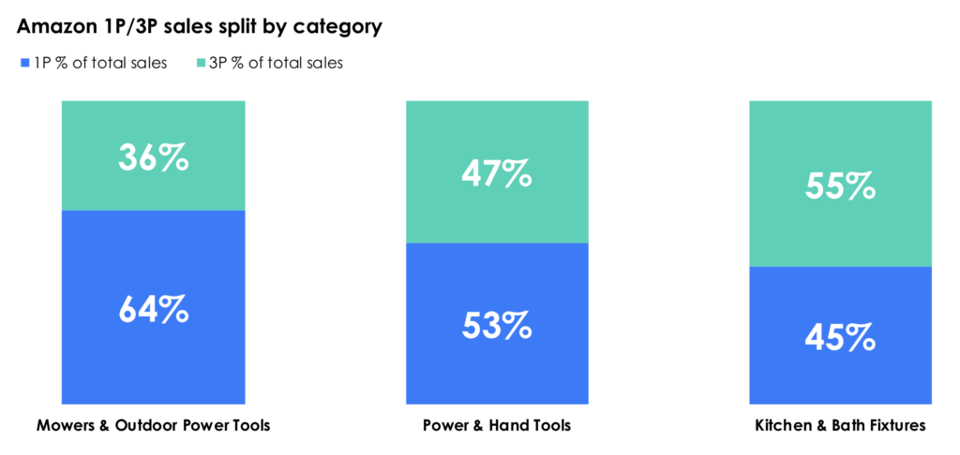
Source: Profitero
3. The Amazon Marketplace reacts quickly to market demand
Making things even more challenging, Amazon’s 3P marketplace is a dynamic beast. Take the example shown below — a strong-selling bathroom faucet brand in the U.K. Besides the product being sold directly (1P) on Amazon.co.uk, there are also 11 different 3P sellers offering the same item. Consequently, on any given day, one of them can drop the price to gain the buy box and steal away some of your sales.
Inventory issues like out-of-stocks are also a huge deal on Amazon, playing right into the hands of 3P sellers. If you run into stock issues (which frequently happens on Amazon), there’s likely a 3P marketplace seller waiting to pick up the slack. This underscores the importance of having the ability to regularly and routinely monitor your assortment and the marketplace situation for your products. If you don’t, you’re in danger of losing control of your distribution and sales on Amazon.
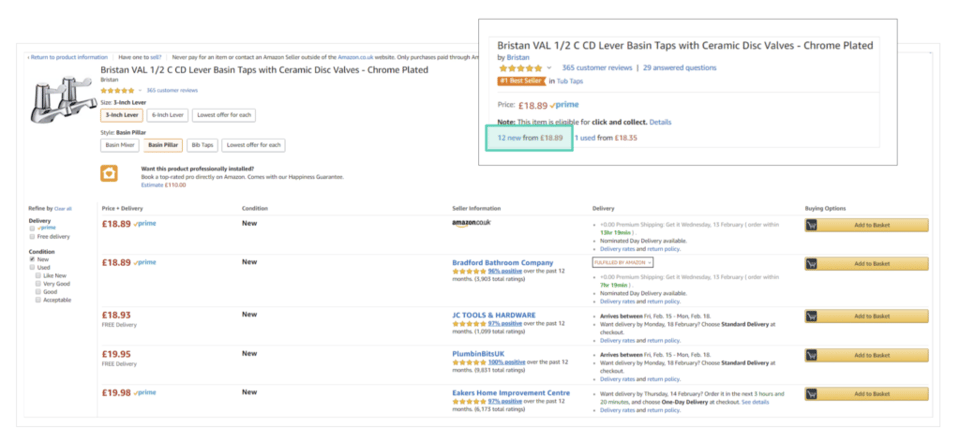
4. Marketing & merchandising dynamics change daily on Amazon
As an online business, Amazon’s competitive and marketing dynamics change more quickly compared to a brick-and-mortar retailer, and these changes can have a bigger impact.
The chart below shows the month-over-month Amazon share growth for a brand in the home improvement space. (Share represents the percentage of total sales a brand has within a given category over a period of time, and therefore is a good measure of competitive strength. The higher your share, the better you are competing; increasing share means you are kicking butt!)
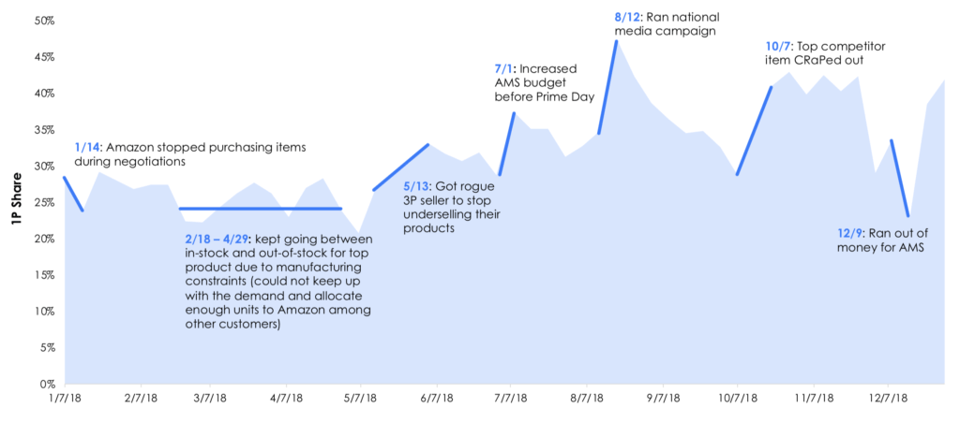
Source: Profitero
On Amazon, there are many factors that can influence whether you are winning or losing on any given day. This is the same as any retailer. But on Amazon, these factors can be influenced daily. For example:
- In a brick-and-mortar store, promotions have to be planned months in advance. But Amazon has its own advertising program built into its platform that virtually allows brands to sponsor keywords and bump up their search position, and sales, at will. You can run a promotion or drop a coupon, and affect a change on Amazon anytime you want … but guess what? So can your competitors!
- Unlike a brick-and-mortar retailer, Amazon has the ability to de-list products overnight if they become unprofitable to ship (known as being “CRaP-ped out”) — even if they sell at high volumes. Amazon can also designate products as “Prime Exclusive,” reducing their visibility and, ultimately, sales by 20%, according to Profitero’s research.
These kinds of ongoing dynamic activities can massively swing sales and market share away from — or toward — your favor.
You need to be on your game 24/7. And most importantly, you need analytics to help you understand which factors are moving your sales and share up and down most, or otherwise, how can you prioritize where to focus?
5. Amazon has its own unique “traffic events” to leverage
Just as in the brick-and-mortar world, be sure to stay on top of your category’s online seasonal promotions (e.g., Spring time for Mowers & Outdoor Power Tools), since they can play out big too when done right.
But unlike in brick and mortar, you also must pay attention to the magnitude of unique online traffic events, like Cyber Monday and Prime Day — the latter, a “manufactured” promotional event first launched by Amazon in 2015 to celebrate the retailer’s 20th anniversary. These days, Prime Day is pretty much considered a mid-year sales-boosting event that happens (in July) during a typically slow time on the retail sales calendar (i.e., post the big summer holidays but before back-to-school).
The chart below illustrates the level of sales spikes the Tools & Home Improvement category can expect on Prime Day (July 16-17 in 2018) and the all-important Q4 holiday seasonal events of Black Friday and Cyber Monday. Circle these days on your events calendar: promotions can pay off big for brands that participate. It’s not uncommon for brands running promotions to double or triple (or even more) their sales during these online events versus their average daily sales.
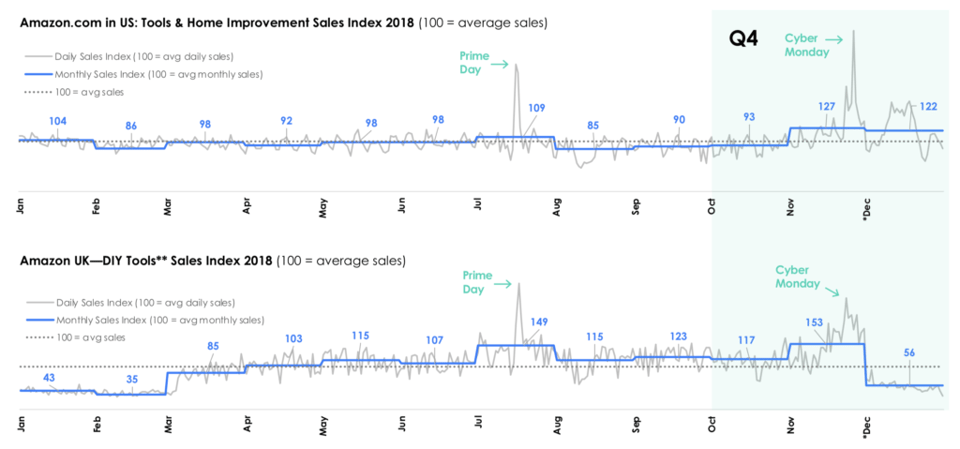
Source: Profitero; Time period: Jan – Nov 2018; *Dec reflects 2017 data; **DIY Tools trend does not include Mowers & Outdoor Power Tools
To learn more about executing on Amazon, view our on-demand webinar The Amazon Imperative: How to accelerate sales in the Tools & Home Improvement category


























